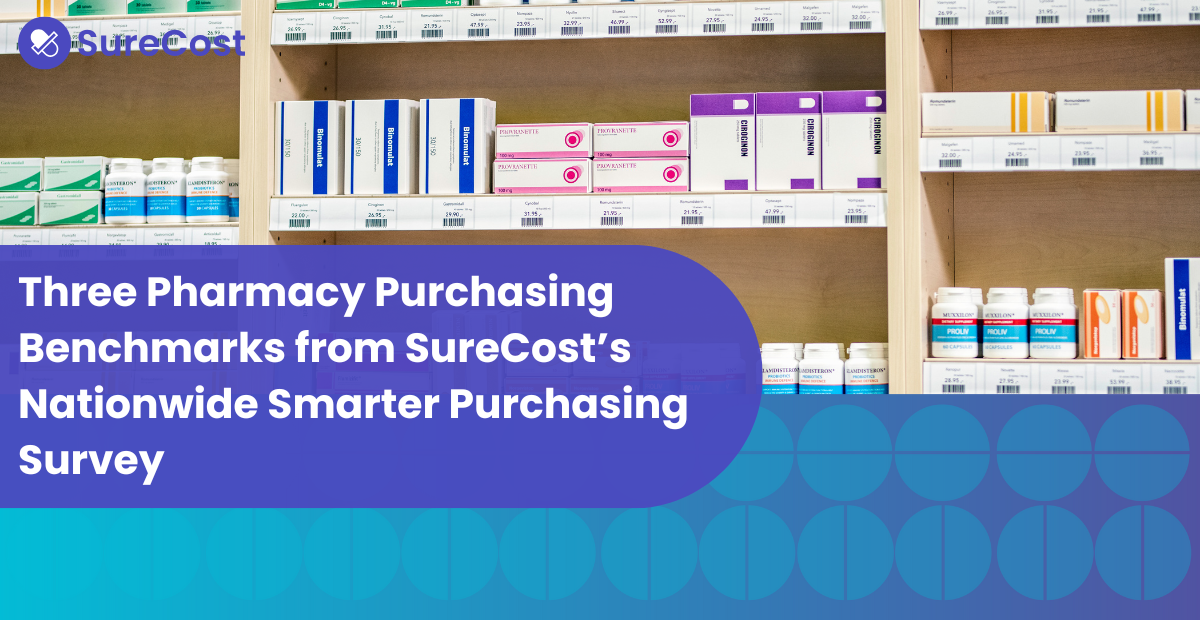You’ve probably seen the news that pharmacy staff from Walgreens, CVS are saying that they’re at a breaking point. You may also have read the statistics where 194 pharmacists were asked whether burnout has contributed to understaffing at their facility, and 75.8% of respondents said yes, whereas 13.9% answered no and 10.3% were unsure. . But as a pharmacy professional, there’s a good chance you already feel the effects of pharmacy staffing shortages.
Pharmacy work was always challenging. And its rewards usually outweighed the pressures. But now, we’re all doing more than ever with fewer hours and smaller teams. Much of our work goes beyond what we expected to do when we joined the field. Feeling stressed, concerned, or frustrated is understandable. Still, in order to succeed even as staffing shortages increase, pharmacies must retain their skilled personnel—the people their patients know and trust.
This blog post will show you how smarter purchasing mitigates the effects of staffing shortages. We’ll discuss strategies to save time and money. You’ll learn how to empower your staff to focus on the work they care about so they’re (literally) there for your patients. Staffing shortages may continue to rise, but you can protect your pharmacy’s quality of care and your business’s bottom line.
The Scope of Staffing Shortages
It’s safe to say that staffing shortages are an industry-wide problem; just look at the results of a 2023 NCPA survey of pharmacy professionals in the United States: 58% reported difficulty filling open positions even as 87% said that pharmacy technicians are in the highest demand (followed by front-end staff at 41% and pharmacists at 32%).
Alongside these gaps in available help, the current workforce is more burnt out than ever. A Pharmacy Times survey reported self-reported burnout among pharmacy professionals more than doubled after the COVID-19 pandemic. On a scale of 1 to 7, with the highest number indicating extreme burnout, respondents reported an average rating close to 6!
Explaining both the insufficient number of available pharmacy staff and the high rate of burnout among them is a whole other discussion. But we’ve all experienced how we got here:
- An increasingly complex patient profile requiring more knowledge and attention
- Post-pandemic demands such as new vaccines, sanitary procedures and patient inquiries
- Single pharmacy locations serving more expansive geographic areas in rural regions
- A wider portfolio of responsibilities including procurement, inventory management, customer checkout, contacting physicians, etc.
In short, there’s a shrinking pool of qualified personnel ready to fill a lot of positions that encompass multiple roles for an even larger number of patients with a variety of needs.
The most obvious impact of staff shortages is fewer people filling prescriptions and counseling patients. That leads to longer prescription wait times, not replenishing stock on time and spending more than you should on products. This can easily affect the patient’s medical treatment and budget. But a burnt-out workforce is also more likely to make mistakes ranging from failing to order items to dispensing the wrong medication.
There’s also a significant financial impact on your business. Training new staff costs time and money. So does paying overtime to staff covering an open position. Turnover for a single pharmacy technician costs one Providence-based hospital up to $35,000 each time. Their cost for a pharmacist turnover is sometimes up to six times greater.
Use Smarter Purchasing to Mitigate Staffing Shortages
Unfortunately, it doesn’t look like this challenge is going away anytime soon. Barring a huge influx of qualified candidates or a drastic reduction in patients or their medical issues, pharmacies have to make the most of their time and save as much money as possible in other ways. You need strategies to work smarter and cut costs.
Smarter purchasing enhances every aspect of your business, and we’re available to cover its myriad functions and benefits. For now, we’ll focus on three strategies tailored to help you weather staffing shortages.
Unify Purchasing to Streamline the Process
Nobody became a pharmacist because they enjoyed shopping. However, many pharmacy professionals are responsible for purchasing management: checking what needs to be ordered in which quantities, comparing multiple catalogs to find the correct products at the best price and uploading purchase orders through each vendor’s website.
Procurement is a time-consuming, often tedious process. There are thousands of product listings—including single products appearing in multiple categories—across multiple interfaces. Your team can spend hours trying to find the right product (without even knowing if it’s the best purchasing option). Even if the process wasn’t burning out staff, it’s taking them away from patients.
Using a single solution to manage purchases from all your vendors saves time. It also makes an otherwise boring, repetitive task into a quick and easy process so staff can get back to serving patients. They can quickly compare vendors and submit purchase orders through one interface. Primary vendor assurance and package-level verification ensure staff don’t have to stress over compliance with vendor agreements and upcoming DSCSA updates. Three-way invoice matching and integration with Accounts Payable also make it easy to confirm you’re getting the right product at the correct quantity for the agreed-upon price.
Plus, you open up new purchasing options and opportunities for savings. You can quickly access and compare products—and packaging options—from secondary vendors as well as your primary vendor. Nearly 70% of pharmacies using SureCost to unify their purchasing management found significant savings shopping outside the “Top 200” generics and an average annual savings of 2% (while seeing why the lowest price isn’t always the best purchasing option).
Use Data to Drive Decisions and Strategy
Purchasing isn’t just tedious; it’s often a complex system of agreements and relationships. Chances are you’re not just buying products. You’re also accounting for:
- Minimum volume
- Cost of goods sold
- Reimbursement margins
- Product consistency
- Cost to change an NDC
That’s a lot, even for a dedicated purchasing manager to track. But how many people on your team are “only” responsible for procurement? You need to make every purchase count. You have to ensure you’re saving money and finding the best purchasing option every time, regardless of who’s placing orders, by using data to drive purchasing decisions.
A smarter purchasing solution like SureCost enables you to automate selected purchasing decisions and drive purchases to specific items. For example, you can maximize rebates by automatically adhering to key components of your primary vendor agreements (such as minimum purchase volume to qualify for tiered pricing, compliance rate for source items and included/excluded items from cost plus). You can trust that your team will always make the right purchases. You also ease the pressure behind purchasing for them.
Beyond the daily benefit to staff, data-driven decisions support your overall business strategy. Analyze compliance metrics (such as total spend on brands versus generics) daily in real time. Easy access to purchasing and inventory data, combined with flexible reporting reveals insights into purchasing trends to make informed decisions. But, like your unified solution above, this level of sophistication and ease when working with your pharmacy’s data requires the right technology.
Leverage Technology and Automation
Technology can never replace a qualified pharmacy professional. But it can enhance how they work and ease the burden of repetitive tasks. That’s why it’s crucial to embrace the right technology. It allows you to automate the menial tasks and repetitive work that pull your staff away from patients, leaving both frustrated. Instead of sifting through thousands of lines in a catalog, use a solution that flags the best options and automatically calculates potential losses.
You can also automate repetitive tasks or decisions that don’t require specific knowledge For example, if you’re ordering the same product every month, you can program that order as well as notifications and updates. SureCost also lets you automate tasks like identifying better savings opportunities, flagging external or internal errors or generating daily reports.
The right solution also bridges purchasing, inventory, pharmacy management systems, accounts payable and compliance with vendors and regulations. Forcing staff to navigate multiple databases or processes doesn’t just burn them out. It leaves everyone open to manual errors. That affects staff, patients and your business.
Benefits Beyond Staffing Shortages
Technology is no longer a luxury. It’s key to your pharmacy’s success. Taking these tasks off your staff’s desk saves them time they can use to serve patients, which is likely why they joined the pharmacy industry.
Yet these strategies will prepare your pharmacy to weather staffing shortages and other challenges such as:
- Drug shortages
- Increased drug prices
- DIR Fees
- New DSCSA regulations
All of these issues can lower margins, increase your workload and cost you time, money and peace of mind. That’s why you need every means to save money where you can and work smarter while maintaining compliance and other relationships with your trade partners. A smarter purchasing solution is how you meet these challenges.
.png?w=500)



.png)


